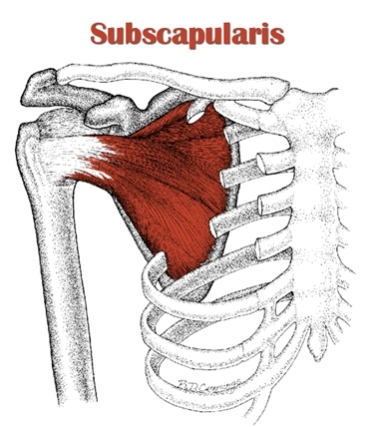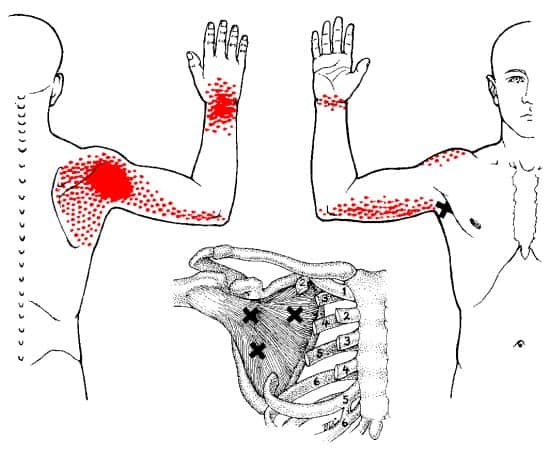The subscapularis (L. sub, beneath ; scapularis, shoulder blade.) is the largest of the four rotator cuff muscles. As its name suggests, it is situated on the underside of the scapula.
It acts on the shoulder joint and is the prime mover in shoulder internal rotation.
It also promotes shoulder stability by resisting anterior translation and (to a lesser degree) superior translation of the humeral head.
The subscapularis is part of the scapulohumeral (intrinsic shoulder) muscle group. It is found deep to the scapula and the other three rotator cuff muscles.
It arises from the anterior scapula, moves laterally and converges before crossing the front of the shoulder joint and inserting on the lesser tubercle.
The fibers of the subscapularis run obliquely between multiple septa, creating a multipennate fiber arrangement.
Also Called
- Subscap
- Rotator cuff
- Internal rotator
Table of Contents
Origin, Insertion, Action & Nerve Supply
| Muscle | Subscapularis |
|---|---|
| Origin | Subscapular fossa of the scapula |
| Insertion |
|
| Action |
|
| Nerve Supply | Upper and lower subscapular nerve (C5-C6) |
Exercises:
Dumbbell Exercises:
- Side lying shoulder internal rotation
- Side lying shoulder internal rotation (on bench)
- Prone shoulder internal rotation (on bench with arm supported)
Cable Exercises:
- Standing shoulder internal rotation
- Seated shoulder internal rotation
- Standing upright shoulder internal rotation
- Seated upright shoulder internal rotation
- Side lying shoulder internal rotation (on bench)
Machine Exercises:
- Shoulder internal rotation
- Upright shoulder internal rotation
Stretches & Myofascial Release Techniques:
Stretches
- Doorway subscapularis stretch
- Broomstick subscapularis stretch
Self Myofascial Release Techniques
When using these techniques, give special attention to the common trigger points shown in the image below.
Tool
- Backnobber II
- Lacrosse ball
Common Issues:
- Short/Overactive Subscapularis: The subscapularis is often short and overactive in individuals with upper crossed syndrome (UCS). The shoulder internal rotation that is characteristic to UCS facilitates the subscap and puts in a chronically shortened position. The initial cause of internal rotation and the accompanying subscapularis overactivity is poor postural habits throughout the day (e.g. hunching over, typing, texting) and overuse of the internal rotators from a disproportionate focus chest exercises and lat exercises. The external rotators become inhibited and stretched out due to the subscap and other internal rotators becoming overactive and shortened, often resulting in poor external rotation and abduction range of motion.
- Inhibited (but not necessarily lengthened) Subscapularis: The subscapularis can get overused to the point that it becomes inhibited from an inability to recover from fatigue or some type of soft tissue problem (e.g. trigger points, adhesions/scar tissue or other damage). This is seen in guys who do a lot heavy bench pressing (and not enough mid-back/scapular stabilizer training or mobility work). The stress from the constant benching takes its toll on the subscap, causing it to effectively shut off. The much larger pecs take over internal rotation. With the subscapularis inhibited, it is less able to resist anterior and superior translation of the humeral head, leading to posterior capsule tightness and instability impingement. Also, the infraspinatus and teres minor become overactive in order to compensate for the subscap as humeral head depressors; overactive external rotators, combined with an inhibited subscapularis, may produce an internal rotation deficit.
Training Notes:
- If you have overactive/short subscapularis, do the following:
- Release and stretch the subscapularis. Unfortunately, myofascial release of the subscap can be challenging because of its hard-to-reach location. The ideal option would be to go to a good massage therapist. Otherwise you’ll have to hit underside of your scapula (by going under the armpit) using the techniques mentioned earlier – or you can try this technique.
- You can optionally choose to do maybe a couple sets of shoulder internal rotations (see exercises above). This can keep the muscle functioning during internal rotation, which is important to prevent it from becoming inhibited by the larger pecs and lats. Keep the amount of work minimal; just enough to activate the muscle. To be clear, this is only appropriate if you’re also stretching and releasing the muscle, as described in the previous bullet point.
- Release and the other internal rotators, especially the pecs and lats.
- Strengthen the external rotators, namely the infraspinatus, teres minor and posterior deltoid. Two great exercises for targeting these muscles are face pulls with external rotation and side lying external rotations.
- Do more training volume on horizontal pull exercises (e.g. rows) and less training volume on horizontal push exercises (e.g. bench press).
- Try to replace exercises that use a lot of internal rotation with alternatives involving less internal rotation. For example, do dumbbell neutral grip bench press instead of barbell bench press, and chin ups or neutral grip pull ups instead of conventional pull ups.
- Address upper crossed syndrome or any other muscular imbalance issues that may be contributing to the subscapularis problem. See how to fix upper crossed syndrome (article coming soon).
- If you have subscapularis weakness, do the following:
- First and foremost, if you think there’s a possibility that subscapularis weakness may be due to a tear or other injury, seek medical help as soon as possible. Don’t try to fix it on your own.
- Strengthen it by doing direct subscapularis exercises. I’ve tried the prone shoulder internal rotation and it was very effective for isolating subscap. Use relatively light weights for high reps (8-20 reps per set). Do 2-3 sets up to 3 times per week and gradually increase resistance and/or training volume.
- Release and stretch the the pecs and lats, as well as the infraspinatus and teres minor.
- Release the subscapularis. But don’t stretch it; you don’t want to lengthen the muscle. Rather, the goal is to use massage/myofascial release to improve the quality of the tissue around the subscap, which usually pretty bad. Better tissue quality means better muscle activation and range of motion.
- Follow the last three bullet points under training note #1, above.




Hi Alex,
Hope you are well
My question is what causes the subscap to have an internal rotation deficit. I have an internal rotation deficit and my teres minor and bicep get tight. I saw a chiro who places his thumb on the front part of the shoulder and temporailiy the ROM came back but then the deficit returns.